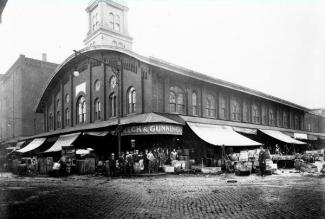
Walk South down 2nd St and stop in front of the Society Hill Towers for the first half of this episodes. At 6.45, the episode shifts to the Powell House, located at 252 S 3rd St. Proceed to the Powell House for the second half of the episode.
116 Dock Street
Philadelphia, PA 19106
United States
Society Hill is one of Philadelphia’s oldest neighborhoods, with more buildings surviving from the eighteenth and nineteenth centuries than any other in the country. Usually defined by the boundaries of Walnut, Lombard, Front, and Eighth Streets, this area south of Independence National Historic Park evolved over the centuries as a diverse, complex residential and commercial neighborhood. Although deteriorated by the 1950s, it was reborn as a city historic district and attracted international attention for its innovative combination of urban renewal and preservation. The area went from being well below the poverty line to one of the city’s most affluent neighborhoods. While the area did become much cleaner and safer most of the previous residents were displaced through gentrification.
Society Hill’s history begins in 1682, when William Penn first set foot in his new colony at the point where Dock Creek poured into the Delaware. To spur development, he gave a charter to “The Society of Free Traders” and a strip of land in the same area, which became part of Philadelphia when Penn’s surveyor sketched the grid centered on High Street (now Market), a few blocks north. The Society flew its flag on the top of a small hill that soon became known as “The Society’s Hill.”
All social classes and both enslaved and free blacks moved to the growing neighborhood, with larger houses on the main streets and smaller quarters filling in back streets and alleys soon added to the grid. By 1776, the neighborhood had a diverse population. The elite built freestanding mansions such as the Physick House and townhouses such as the Powel House. Close by were smaller structures for servants and workers, particularly those from the nearby waterfront. Further inland were the homes of tradesmen, craftsmen, and others.
Over more than three centuries, Society Hill evolved from a mixed-use neighborhood of a colonial town to a big city ward that contained skid row and slum, and now to a gentrified “gold coast.” Its recent history includes a largely successful effort to return its former glory as an urbane village of historic homes (and, now, luxury high-rises), but one largely stripped of the industrial, commercial, and civic institutions and the visible racial and ethnic minorities that once filled its streets.
Sources & Further Information
- Society Hill Urban Renewal: The Untold Story of Displacement
- From slums to sleek towers: How Philly became cleaner, safer, and more unequal
- Society Hill: Philadelphia, Pennsylvania
- Encyclopedia of Greater Philadelphia | Society Hill
- When did Society Hill become a city-state unto itself? | Inga Saffron
- Society Hill was an urban planning masterpiece. Will these new towers ruin the design? | Inga Saffron
- Preserving Philadelphia's Society Hill | Penn Today